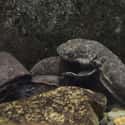-
(#7) The Ying And Yang Symbol May Have Originally Featured Giant Salamanders
According to the BBC, these salamanders might be responsible for one of the most iconic images on earth. The classic depiction of yin and yang is a symbol of great importance when it comes to the philosophy of Taoism, a Chinese religion and school of thought. It is possible that this beautiful symbol was originally shown as illustrations of two salamanders, which is a pretty breathtaking result coming from such an ugly animal.
-
(#5) They Are Sometimes Called 'Baby Fish' Because They Sound Like Crying Infants
There are a lot of creepy things about Chinese salamanders; they have slimy skin, beady eyes, and a mouth that looks big enough to swallow a cat whole. But all of these features are nowhere near as terrifying as the sound they make.
The Chinese will sometimes refer to the salamander as a “baby fish,” a nickname that is probably too cute for such an ugly creature. They call it that because, when in distress, giant salamanders emit a whining wail that sounds eerily similar to a crying human baby. So, if you’re ever exploring rural China and hear a ghostly cry coming from the water, don’t worry - you’re not dealing with an evil spirit. You likely freaked out a giant salamander.
-
(#1) The Largest Salamanders Can Be Nearly Six Feet Long
The Chinese giant salamander is the largest amphibian on Earth. While the average size for the species is around 3.5 feet, one salamander in the wild measured out to an astonishing 5.9 feet, which is a record for this species. These animals are barely over an inch long as tadpoles, making their monstrous size even more impressive. They grow slowly over the course of their lives, not reaching sexual maturity until they are about 5 years old. In captivity, Chinese giant salamanders have been documented to live for up to 60 years.
They’re also packing some serious meat on their bones. The average giant salamander weighs about 66 pounds, which is pretty remarkable for an amphibian.
-
(#9) They Breathe Through Their Skin
In general, amphibians are pretty bizarre. They are cold blooded, extremely sensitive to environmental changes, and go through an extreme metamorphosis from tadpole to adult. They can also breath and absorb water through their skin, a trick that helps them survive both in the water and on land. But their unique skin also makes them very vulnerable. Amphibians can’t help but soak up any toxic chemicals they come into contact with, and they often are the first to die off due to the effects of pollution. The giant Chinese salamander is no exception to this rule and their numbers have been severely effected by increased levels of habitat contamination.
-
(#11) They Can Excrete A Deadly Toxin From Their Skin
Predators beware, the giant Chinese salamander has a handy trick to deal with potential enemies. When threatened, they can produce a toxic enzyme that is released through the skin. This enzyme can have seriously debilitating effects on mammals, including symptoms like edema and nociception. High concentrations of this enzyme have been observed to cause death in lab rats.
-
(#4) They Are Adept Predators, But Are Increasingly Being Hunted Themselves
Not surprisingly, these lumbering giants are highly successful predators. They will consume all sorts of different prey, but they specialize in small arthropods like crustaceans and insects as well as other aquatic species. Fish and other amphibians are also important parts of the giant salamander's diet.
Giant salamanders have been increasingly hunted themselves, mostly by poachers looking to make a quick buck. As their population declines, poachers have stooped to using dynamite and poisonous chemicals to suss out the rare amphibians. These hunting strategies are not only killing the salamanders, but they could also be harming their sources of food.
New Random Displays Display All By Ranking
About This Tool
Chinese giant salamander is an amphibian that lives in freshwater. This is a rare and unique wild animal in China. Although it lives in the water, it is not a fish, but the largest amphibian on earth. Their body length is generally about 1 meter, and the longest can reach 2 meters. Wild Chinese giant salamander generally active in clear, low-temperature streams or natural caves, inhabiting mud or dark rock crevices.
Chinese giant salamanders are extremely rare animals, and the rapid decline in habitat and pollution caused the number of Chinese giant salamanders to decrease sharply, which is also the main reason why this species is endangered. Here the random tool introduced 11 details about the largest amphibian.
Our data comes from Ranker, If you want to participate in the ranking of items displayed on this page, please click here.
















